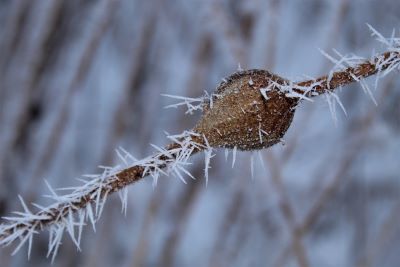
Good Natured: Goldenrod Galls
Longtime Good Natured readers might recall an old column (a 6-year-old column, to be exact) where we delved into the beguiling world of goldenrod galls. But you know what? That piece actually was an update of an older article from 2013, and that one, believe it or not, was a revision of a column from either 2008 or '09.
(True confession: That Goldenrod Galls First Edition along with many other early writings were stored on compact discs, which were then stowed in the basement at Hickory Knolls. Remember the scene at the end of Raiders of the Lost Ark, where the Ark of the Covenant was crated, sealed and wheeled into a vast government warehouse? It was kinda like that, only with boxes of teaching materials and random plant and animal parts. And, somewhere, a small box of CDs…)
At any rate, it's clear that we here at Good Natured World Headquarters get positively goofy whenever the subject of goldenrod galls comes up. Which it did, just the other day.
Walking past a field of goldenrod, we couldn't help but notice the great number of bulbous galls on the plants' stems. Most were round, indicating the work of Eurosta solidaginis, a fruit fly in the family Tephritidae, but some were elliptical, produced by the elliptical gall moth. (You might think I'm being facetious, but that term truly is the insect's common name. If you prefer the scientific though, take a crack at this: Gnorimoschema gallaesolidaginis. Loosely translated, it means goldenrod gallmaker of well-known shape. Or something like that. We'll delve more into this species later.)
The average person might walk past these gall-laden plants and not give them a second glance. Or, if they did, they might lament the distorted stems and move along. But in so doing, they'd be missing out on some of the most remarkable--and most easily observable connections--in our local ecology.
Let's start with the round galls of the goldenrod gall fly, which get their start in late spring when females deposit individual eggs in the plant's terminal buds. (More taxonomy fun! The flies favor two goldenrod species, Solidago altissima or tall goldenrod, and giant goldenrod, S. gigantea. The former has hairy stems, the latter, smooth; both also are tall and, at up to 6 feet high, relatively giant.)
Each egg hatches in a week or so, and the wee larva burrows its way down into the pith, or spongy middle part of the stem. Once ensconced, it goes about its business of feeding on plant juices and growing. As it gets bigger, so too does the plant tissue around it, likely in response to compounds emitted by the baby bug.
As fall sets in, the little tyke prepares for diapause, the insect version of hibernation. But before that dormancy can set in, the larva must perform one crucial task: excavating an exit tunnel. Using a pair of mouth hooks, it digs through the corky tissue of the gall, stopping just short of the outer epidermal layer.
Why is this such a big deal? Because as an adult, the goldenrod gall fly has no chewing mouthparts. If it didn't make those vital arrangements ahead of time, it would remain forever inside the gall and its story, and species, would be fleeting.
Luckily though, the goldenrod gall fly larva is preprogrammed to perform that fall dig. Afterward, its vital work complete, it replaces most of the water in its body with glycerol, an alcohol that acts like antifreeze, and settles in for a long winter's nap.
Tick, tick, tick…ding!
As if triggered by an internal alarm clock, the larva rouses as the weather warms, and enters its next life stage: pupation. Cells divide, wings, legs and antennae appear and before long, a newly minted adult makes its appearance in the outside world—but not before one more amazing feat.
Various types of flies, including E. solidaginis, are equipped with a structure called a ptilinum. It's used only once, but its function is invaluable.
Like a tiny water balloon (filled with hemolymph, or insect blood, rather than actual water) the ptilinum inflates from a groove at the front of the head. It protects the fly as it pushes through the remaining goldenrod tissue at the end of the exit tunnel. But—unlike water balloons, which pop--this awesome organ collapses and reverts, never to be seen again. The only indication of its existence is the teensy ptilinal suture at the base of the antennae.
Compared to their unmistakable larval homes, adult gall flies live life in relative anonymity. Smaller than house flies and staying, predictably, around goldenrod, they're seldom noticed as they go about their business of mating and depositing eggs.
It might seem as though these various life stages progress smoothly and predictably, year after year. Yet that view would ignore the vast array of connections--what I like to think of as drama and intrigue--these insects and goldenrod dwellers share with their surrounding environment.
Next week: We dive deeper into goldenrod gall ecology.
Pam Otto is the outreach ambassador for the St. Charles Park District. She can be reached at potto@stcparks.org.

